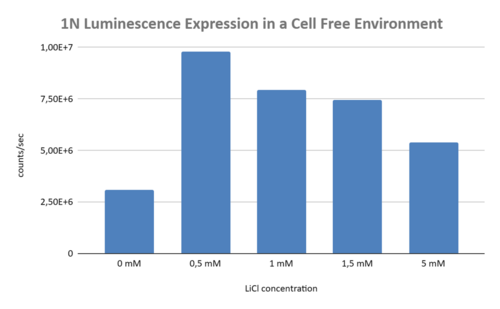According to the German Society for Bipolar Disorder (DBGS), 2.5 million people in Germany are affected by Bipolar. Bipolar can be treated with lithium therapy. The therapy has shown high efficacy particularly in preventing suicides. However, since there is a risk of intoxication due to lithium, regular monitoring of the lithium level in the blood is necessary. During the first four weeks of therapy, this monitoring should be done weekly.

Our goal is to develop a testing system for lithium levels. The testing system should be characterized by easy handling and provide reliable results. Patients should be able to independently check their lithium levels at home. This will enable early detection and prevention of intoxication.
To detect lithium, we are using a recently discovered Li+ riboswitch. Riboswitches function in a biological context like a switch that can turn genes ON/OFF. We can use this riboswitch in our system to generate a signal in the presence of Li+. The signal will allow us to quantitatively determine the lithium level in patient blood samples. This requires that we can measure therapeutic concentrations between 0.6 and 1.2 mM and toxic concentrations > 1.5 mM in the blood.
To tackle these challenges, we have adjusted our riboswitch and tested it in combination with several reporters with different properties. Details and a description of the riboswitch can be found in our wiki.

The riboswitch in combination with the NanoLuc reporter has proven to be the best combination for the requirements of our test system. NanoLuc is a customised enzyme originally derived from the deep-sea shrimp Oplophorus gracilirostris. The luciferase generates a signal by bioluminescence and is characterised by its high sensitivity, stability and small enzyme size.
In a cell-free system, we were able to show that we are able to measure the concentrations relevant for lithium therapy. Now we need to fine-tune the system. The decreasing signal with increasing lithium concentration indicates that the substrate concentration is too low. This means that the substrate is used up more quickly at higher lithium concentrations and we measure a lower signal. Tuning the substrate concentration could eliminate this correlation.
Deutsche Gesellschaft für bipolare Störungen e.V. (DGBS). (2023, April 19). dgbs.de. dgbs.de/bipolare-stoerung/verlauf
Lewitzka, U., Haußmann, R. Lithium - ein Update. InFo Neurologie 24, 44–53 (2022). doi.org/10.1007/s15005-021-2201-4
Song J, Sjölander A, Joas E, Bergen SE, Runeson B, Larsson H, Landén M, Lichtenstein P. Suicidal Behavior During Lithium and Valproate Treatment: A Within-Individual 8-Year Prospective Study of 50,000 Patients With Bipolar Disorder. Am J Psychiatry. 2017 Aug 1;174(8):795-802. doi: 10.1176/appi.ajp.2017.16050542. Epub 2017 Jun 9. PMID: 28595491.
Parkin GM, McCarthy MJ, Thein SH, Piccerillo HL, Warikoo N, Granger DA, Thomas EA. Saliva testing as a means to monitor therapeutic lithium levels in patients with psychiatric disorders: Identification of clinical and environmental covariates, and their incorporation into a prediction model. Bipolar Disord. 2021 Nov;23(7):679-688. doi: 10.1111/bdi.13128. Epub 2021 Sep 24. PMID: 34536974; PMCID: PMC9291088.